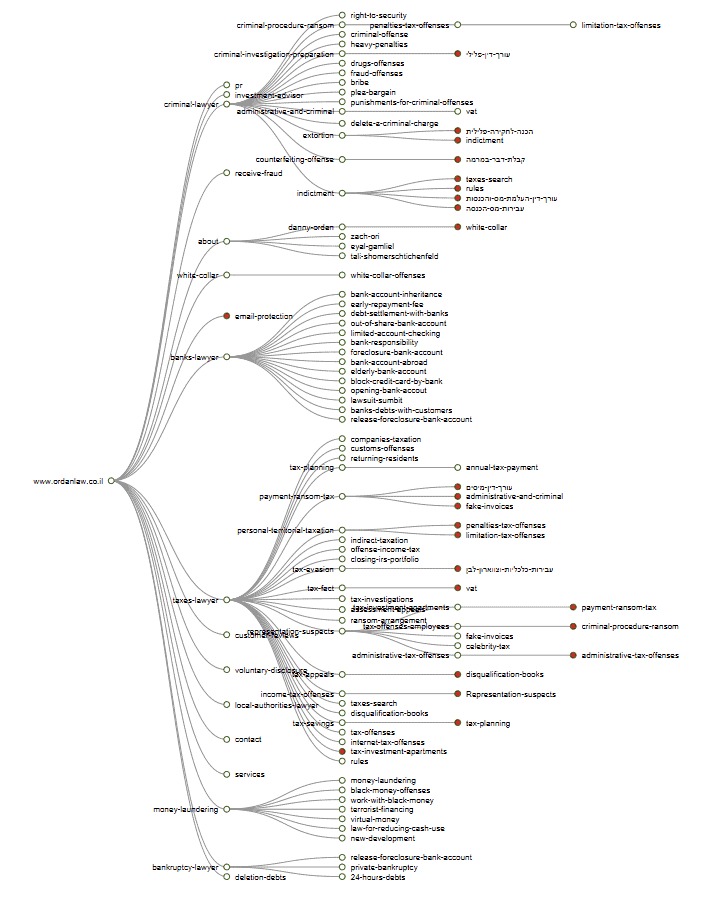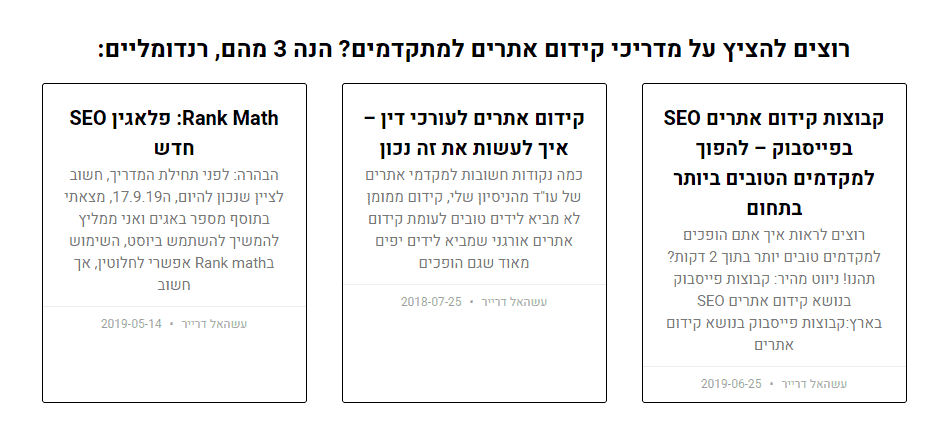Technical SEO refers to a collection of actions performed to improve the infrastructure on which the website is built. Infrastructure is actually the technological casing that enables the website to operate: the storage where the website is managed, the communication traffic encryption technology, the structure of the page addresses on the website, the references between different pages on the website, the error messages presented to the user and other technical aspects of the website’s ongoing operation. Along with optimizing website pages, integrating content strategy, and building a quality link profile, handling the technical side of the site is an important component of any organic promotion process. Let’s try to understand what the components of this part.
Correct hierarchy
Not coincidentally, this section is first listed in the list of steps needed to perform technical SEO. Proper hierarchy forms the basis for the site’s infrastructure, and in many cases, it is relatively difficult to update it after the website is active without damaging, at least temporarily, the website’s rankings, so if you have recently upgraded the hierarchy, expect a decrease and then a good increase if you upgraded correctly.
A correct hierarchy, in most cases, should be based on a tree graph configuration, so that each topic has references to the sub-topics below it. Two standard rules that are important to follow in building a hierarchy are not to exaggerate with the lateral building, nor to exaggerate with the depth building. If, for example, you have reached 5 or 6 levels of website hierarchy – you may need to redesign it or your site contains at least a few hundred pages if not thousands. On the other hand, if you have a hundred products on the website, all under one category named “Products”, you might be able to add a hierarchy level to produce better order and visibility, not only for the user, but also for the search engine.
This is what a good hierarchy looks like (taken from the website: https://www.ordanlaw.co.il which I promote):

Breadcrumbs
Breadcrumbs, are landmarks that reflect the user’s location in the hierarchy of the website, enabling him to navigate more conveniently and effectively between the various pages on the website. Breadcrumbs integrated in the website indirectly help with the promotion process: The user of the website becomes more satisfied with the website browsing, finds it faster, his average number of views on different pages per visit increases, and so does his stay time on site. These metrics signal to Google that the website is user-friendly and easy to orientate. Both Yost and Rank Math offers convenient Breadcrumbs. It is important to understand that Breadcrumbs are considered internal links for all intents and purposes.
Example of Breadcrumbs:

Navigation routes
The Breadcrumbs presented in the previous section are a specific technology solution to improve website navigation. Creating smart and logical navigation tracks for website orientation is an important component of any promotion process. It is not advisable to let the user guess which page will be displayed after clicking link or menu on the website. In many cases, such a work configuration will increase the percentage of website abandonment. Smart navigation roads should be integrated everywhere on the website: in the design of the main menu of the website, in planning the links that appear in the footer, in the categories and in the links embedded in the content itself.
In my website, for example, in all places you will reach at the website, you will be offered additional posts that may interest you, for example, at the end of a beginner tutorial post, I give a taste on advanced posts:

Internal links
There are many benefits of using internal links within the website: starting with more convenient navigation for the user, marking the pages of greater importance for the users for the search engine, reducing the percentage of abandonment, increasing the length of the stay time, increasing the number of page views per visit and more.
Internal links are an integral part of technical SEO, and in many cases, from cost-effective perspective, deliver the goods on the best side.
Site map
The search engines use a site map to better understand the structure of the website. Site map can help search engines prioritize the crawl budget more accurately, and keep up to date with new pages added to the website.
Friendly URLs
Many arguments in the SEO world are around the use of URL in the same language like the website. Some argue, for example, that Hebrew URLs can help the website better position itself on websites that target an Israeli audience. However, the recommendation, which is common to most important site promoters, is to use shortened URLs in English.
The effect of using short URLs is not only evident in the promotion of the website, but in the ability of the website owner to promote content on social networks, without using very long URLs, which are the result of the promotion of the Hebrew letters.
Redirects
Almost every website managed over time contains different pages whose relevance becomes less important over the years. Over time, the need to delete pages from the website or create alternative pages, containing more up-to-date and relevant information, is created. The result of this ongoing activity is that from time to time, the user may come across error pages that indicate a page that does not exist.
To avoid this bad user experience, publishers use permanent or temporary redirects, which direct the user to appropriate pages, preventing them from encountering error pages. These redirects, such as 301 and 302, are actions performed within a technical SEO, the purpose of which is, among other things, to keep the user browsing the website, even in cases where he allegedly would not continue browsing. It is widely assumed that Page A, which 301 redirects to Page B, also directs the external linking power from Page A to Page B.
Friendly Page 404
Even in the case of optimal use of permanent and temporary redirects, of 301 and 302 types, will be created on both large and small websites, quite a few cases where the user reaches 404 page, indicating that the page that was requested no longer exists on the website. 404 pages do not have to be a stop on the way of the user’s exit from the website. They can certainly be a great opportunity to show off a sense of humor and creativity, leaving the user on the website despite seemingly a dead end. There is no more important signaling that matters to Google, for a well-structured website content.
This is what my 404 page looks like:

Redirects to final pages only
Well, we understand that redirects can help us navigate to relevant pages on the website, and that their use is essential, especially for websites managed over time. However, effective use of redirects is an equally important component of website optimization. Ideally, every page reference should be done only once. That is, instances where a page is redirected to another page, which is also referred to as an ineffective method, which consumes more loading time and harms the user experience. The recommendation in this context is to make sure that every page on the website is referral directly to the final version to be used.
Canonical tags
Canonical Tag allows website owners to indicate the search engines that the page contains content that originates from another page. Usually, this will be duplicate content for current operational needs: print pages, product pages in different order or different colors, quotes and more are examples of using content that already exists in one form or another on the website or alternate website. Using a Canonical Tag signals the search engines who the source is and which should be indexed and displayed in the search. In this way, punishment whose purpose is to prevent duplicate content from being created can be avoided. Using the Canonical Tag in the relevant places is a very important action in the technical SEO.
SSL certificate and HTTPS protocol
Google has previously announced that it intends to give low priority to websites that do not use an SSL certificate to secure the user-website traffic (to switch to the SSL installation guide). These days, almost every storage service will offer such a service to the website owners and even support and assistance in installing the SSL certificate. It is recommended to use the HTTPS protocol not only on sales websites that include payment details and personal information, but also on marketing websites where the sales process is offline.
Short website’s loading time
Google attaches importance to the website’s loading time as part of a variety of considerations that guide it in ranking pages on a site on the search results page. The goal is to introduce the user to fast websites with a good and high quality user experience. Improving website loading time is an important method in this regard: Choose high-quality and fast storage, optimize images and videos, use cache to speed up popular page loading time, use AMP pages to display the most accessible and fast pages to the user, and ensure efficiency using CSS and JavaScript functions on the website, for my website acceleration guide click here.
Schemes
Where this is possible, adding a schema is an action within a technical SEO that can greatly improve the visibility of the site in the search engines. Using the schema allows the site owner to present the website’s data to the search engine as structured data, which allows the search engine to better understand the content of the website. Website that integrates schemas as part of website content management provides to the search engine the ability to rank, compare, and display the schema-managed items in a more customized view for user in the search engine. For example, if you want stars to appear in your website’s search results, I’ve written a guide about it.

Mobile website customization
This is an essential and basic component, though it also belongs to the technical SEO. Adjusting the website for display on mobile devices is essential for promoting the website. More and more people are using mobile devices to consume content and a website that does not bother to match its views to these devices will lose its relevance. There are two main ways to customize the display of the website to the mobile world: a responsive display that dynamically adapts to any screen size, and a unique custom display for mobile devices. Making such an adjustment should take into account a large number of mobile browsing features: the buttons on the website should also be convenient to click on mobile devices, far enough apart, suitable for length and width display and more.
Optimize robots.txt file
The robots.txt file is used to provide guidance to various search engines about site crawling and indexing. The robots.txt file can enable or disable indexing of pages on the website as needed: for example, website owners might not want to index administrative pages or pages that contain customer information.
Simple templates
Using a template allows a website owner to easily and effectively manage website content. However, it is clear and obvious that using the template also produces processes that damage the website’s page loading efficiency, certainly compared to using a clean HTML file. When choosing a website template, it will be important to take into account not only the varietal functionality it offers, but also aspects of efficiency, simplicity and clean code that are easily maintainable.
In conclusion
The technical part of SEO is an important component of any promotion process. Alongside the need to build a quality link profile and optimize website content, proper maintenance of the infrastructure on which the website is managed can greatly help improve the website’s locations in the various search engines.





